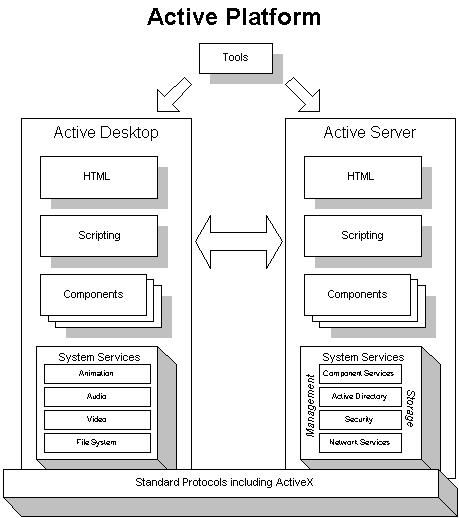Definition of Active Platform in the Network Encyclopedia.
Table of Contents:
- What was the Active Platform?
- Technologies Included
- History of Microsft’s Active Platform
- References
1. What was the Active Platform?
Active Platform was a set of Microsoft technologies for developing applications for the Internet. Applications developed using Active Platform technologies can be accessed and run from any client platform independent of the operating system, as long as a standard Web browser such as Microsoft Internet Explorer is installed on the client.

2. Technologies Included
Active Platform was an umbrella term for three key Microsoft technologies:
Active Desktop:
Integrates the Microsoft Windows desktop with the Internet, providing a seamless connection between local and remote applications and resources. Active Desktop is a core technology of Internet Explorer.
Active Server:
The Active Platform component of Microsoft Internet Information Services (IIS) version 5 or later. Using Active Server technologies, core Windows NT services can be extended to the Internet using applications developed with Microsoft Active Server Pages (ASP) technologies
Microsoft ActiveX:
A component software technology based on the Component Object Model (COM). ActiveX allows distributed Web-based applications to be developed in any programming language and then run from within an ActiveX-enabled browser such as Internet Explorer.
3. History of Microsft’s Active Platform
Project Blackbird
It all began after Microsoft decided to drop a project called Blackbird. Blackbird was an ambitious idea aiming to make web apps feel more like the desktop programs we’re all used to, using something called distributed OLE instead of the usual HTML markup. However, Microsoft quickly realized that Blackbird had some performance issues and that HTML, the backbone of the web, was becoming more popular.
At the same time, Microsoft was facing some stiff competition. Netscape, Sun, Oracle, and IBM, a group sometimes called the “Gang of Four,” were pushing Java as a way to create a sort of Internet Operating System. This would be a big deal because it would run web applications through a browser using Java, challenging Microsoft’s Windows dominance.
Microsoft’s Response
In response to all this, Microsoft unveiled the Active Platform at their SiteBuilder conference in October 1996. Part of this was ActiveDesktop, which Microsoft initially said would work on any operating system. However, it ended up being a Windows-only feature, first showing up in Internet Explorer 4.0 and then in Windows 98. Another component was Active Server, built on IIS 3.0 and featuring things like Active Server Pages and Microsoft Transaction Server. Then there was ActiveX, which used technologies Microsoft had developed for Windows to create OLE-based controls that could be used in web pages and apps.
ASP.NET
However, it wasn’t all smooth sailing. ActiveX, in particular, faced a lot of criticism over security issues, leading Microsoft to eventually shift its focus to the .NET Framework. As for ActiveDesktop, it didn’t really catch on and was dropped in later versions of Windows. The idea resurfaced later in the Windows Sidebar, which many see as Microsoft’s answer to Apple’s Dashboard feature in OS X. Active Server evolved over time too, aligning with the .NET platform, with ASP.NET emerging as a new version of ASP.
4. References
- “Microsoft counters Constellation: ActiveX solution will ensure latest software versions“, by Jim Balderston, InfoWorld. (December 2, 1996)
- “Microsoft Active Platform Sourcebook“, by Donald R. Brewer, Wiley. (October 15, 1997)